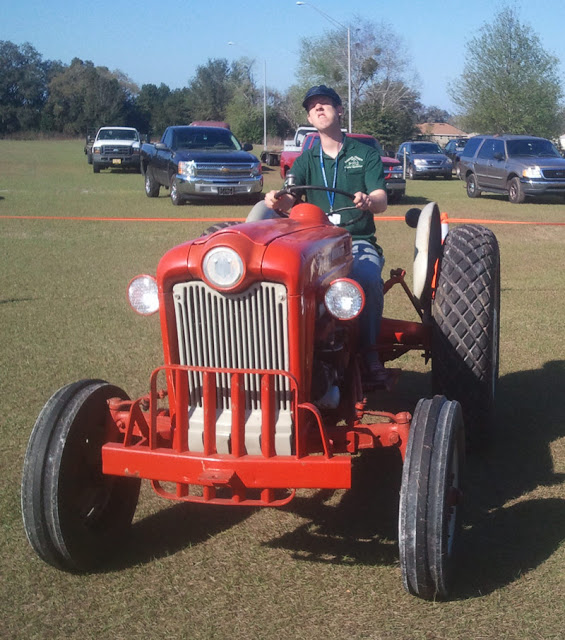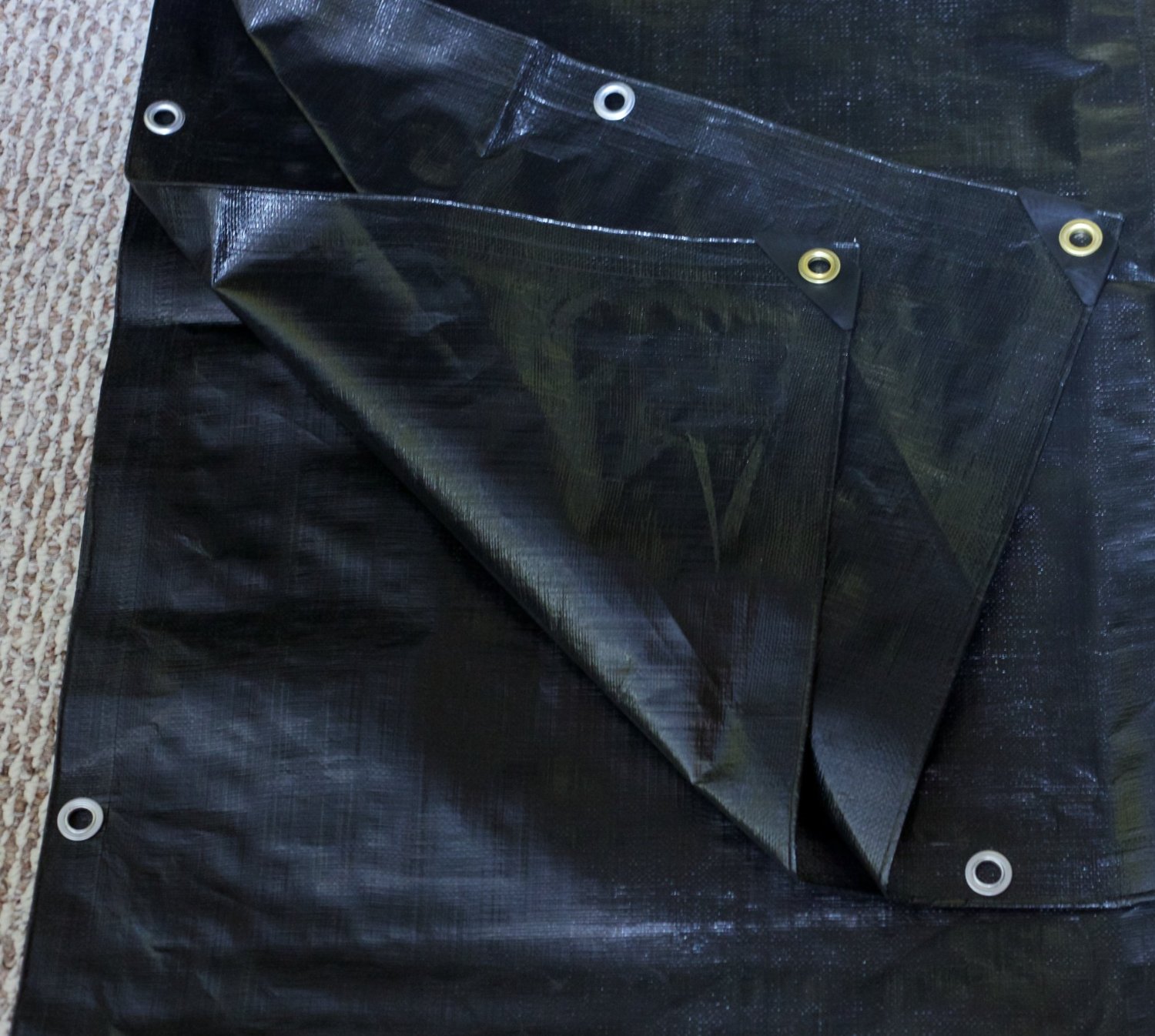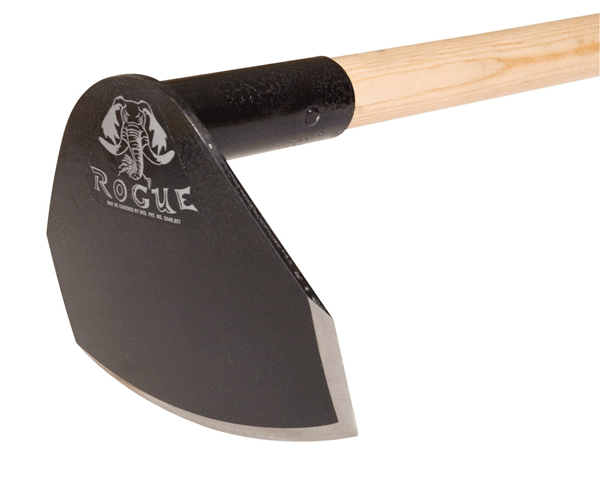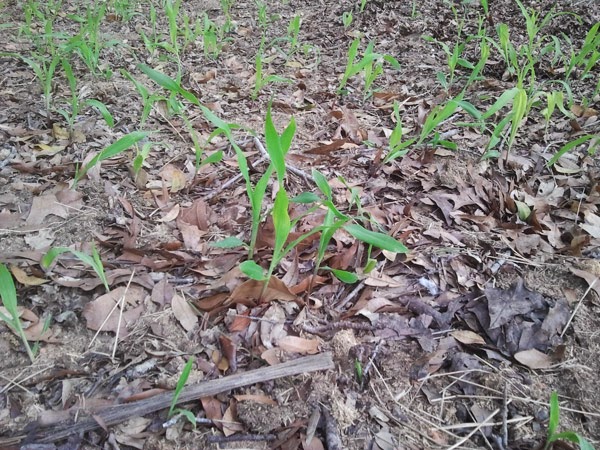
Option #1: Till When it’s Dry

Option #2: Roast It With Tarps
 Some plastic or tarps over the ground during the long hot days of summer will cook the grass beneath pretty quickly, allowing you to later turn under what’s left or mulch and plant right into the frizzled remains of your once-green lawn.
Some plastic or tarps over the ground during the long hot days of summer will cook the grass beneath pretty quickly, allowing you to later turn under what’s left or mulch and plant right into the frizzled remains of your once-green lawn.Option #3: Hack it Out
St. Augustine grass isn’t really that hard to remove compared to some grass. Once you get going, you can carve away big swaths with the right tool.
Something like this would do it:
 Or one of these grape hoes from Easy Digging.
Or one of these grape hoes from Easy Digging.
Pile up the grass and roots someplace where they can dry out – like a concrete slab or on a tarp – and they can later be added to a compost pile.
Option #4: Sheet Mulch
Gather cardboard, layer it down, then pile at least a foot of mulch, leaves, straw or other organic matter on top of it. The grass beneath will suffocate and then be turned into rich compost by the worms.
One of my friends piled up mulch and then planted corn right into it. Amazingly, it worked!

Goodbye, St. Augustine grass – hello deep fertility (and corn on the cob!).
Finally…
As grass goes, St. Augustine really isn’t the worst. It’s better than having bare soil, so make sure that wherever you get rid of St. Augustine grass you have something to replace it, whether gardens, trees, wildflowers or mulch. The soil degrades rapidly when uncovered, so keep it covered.
You might consider just taking out the grass in sections over time, leaving it where you’re not actively working just as a cover for the ground.
Good luck and may you never need to mow again.


11 comments
Good post David. Timely in that I’m expanding my garden and starting to work on a food forest. I have St. Augustine as well, with a few sprinkles of centipede and bahia here and there (I live in the Gulf Coastal area of Alabama). So far I have just been sheet mulching areas that I plan to use the next year, one section or area at a time. The only real limitation has been mulch availability; I pick up as many leaf bags as I can find through the Autumn and Winter, I use everything I can get from my yard (leaves, sticks, debris from pruning, etc.), and occasionally I’ll buy some bagged mulch during the summer months when I run low. Still looking to hook up with a tree service to improve my mulch inventory….
When I find a plant or plants that just have to go in right now, I’ll pull the grass up from the area I’m going to plant (I’ve been using a shovel – having just finished your “Grow or Die” book, I realize now that I need to procure a grub hoe or a grape hoe for this task. Great book BTW!), double dig, and then put the grass at the bottom of the hole before filling it back in.
I agree with you about leaving the grass in areas that you’re not going to be able to cover immediately. Digging it up or killing it and then leaving the soil bare would just be wasted effort. WAY better to have it there than nothing at all, and it makes a nice looking lawn until you can replace it with something to eat.
Easy to kill grass–I used to put the kids cheap plastic pool out in the yard for them to pay. If i didn’t move it every other day the grass turned brown but would come back. If i left it a week it took forever but is would eventually grow back. so cover up what you want to get rid of for a few weeks and no worried, it’s gone.
Thank you David, from the bottom of my literal pea-picking heart! Since I love to cook, I will use your summertime St. Augustine cooking method with the plastic tarp. For more immediate needs, the cardboard and mulch is a great idea.
Problems solved!
I am fighting Bermuda… (much worse than ST Augustine.) I tried the clear plastic method last summer left it on most of the summer… around the edges where water would get in no success… the rest of the soil is just dead! This year tho everything i am planting in that spot is doing fair to good.
But the edges have made sure that I am still fighting Bermuda! evil stuff. I can control it with regular tilling and pulling and removing from the garden… By control I mean keep enough growing area to not hinder my crops… Total elimination is a dream I gave up on realizing.
I tried a deep mulch. That is the best way to feed Bermuda and invite it to take over my garden. So I use what mulch I can for my beds and pull by hand the invaders and use a tiller on the walkways.
I live on the highland rim in N central TN and so the average 1 inch of rain a week keeps things from toasting here.
Tilling the Bermuda in the winter does help freeze it.
Now I am looking for a solution to get Bermuda out of an asparagus bed…
We had the exact some problem with Bermuda when we lived near Nashville. Horrible. I eventually beat it, for the most part, by layering two layers of cardboard over it all, then piling a foot of local tree company mulch on it. If you dug down – even a year later – there were still some living rhizomes, though. Horrid. I feel your pain.
I only have a few patches of St. Augustine taking over my tall fescue in the front yard (gardener error…mowing the backyard first, which is St. Augustine). If I just pull these patches out individually from the roots will they grow back or do I have to kill them with roundup, which will kill my fescue also?
Hand-pulling should get rid of them.
Just spray st. Augustine grass with a strong dose of crabgrass killer and make you think that st augustine is a cousin of the crabgrass. Might turn the bermuda a little yellow for a while, but will not kill it.
My neighbor has st. augustine and I have to spray it about 1 or 2 times a year
Heh. I’ll bet. It’s tough.
Need to kill one row of Augustine grass cause I extended my garden bigger, too hard to dig what to do?
Usually you can dig under it with a sharp spade and slice it off.
Comments are closed.